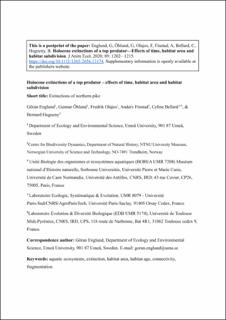| dc.contributor.author | Englund, Göran | |
| dc.contributor.author | Öhlund, Gunnar | |
| dc.contributor.author | Olajos, Fredrik | |
| dc.contributor.author | Finstad, Anders Gravbrøt | |
| dc.contributor.author | Bellard, Celine | |
| dc.contributor.author | Hugueny, Bernard | |
| dc.date.accessioned | 2021-02-24T13:36:07Z | |
| dc.date.available | 2021-02-24T13:36:07Z | |
| dc.date.created | 2020-11-04T16:24:31Z | |
| dc.date.issued | 2020 | |
| dc.identifier.citation | Journal of Animal Ecology. 2020, 89 (5), 1202-1215. | en_US |
| dc.identifier.issn | 0021-8790 | |
| dc.identifier.uri | https://hdl.handle.net/11250/2730158 | |
| dc.description.abstract | Loss of habitat and changes in the spatial configuration of habitats are major drivers of species extinctions, but the responses to these drivers differ between organisms. To advance theory on how extinction risk from different types of habitat alteration relates to species‐specific traits, there is a need for studies of the long‐term extinction dynamic of individual species.
The goal of this study was to quantify how habitat area and the spatial configuration of habitats affect extinction rate of an aquatic top predator, the northern pike Esox lucius L.
We recorded the presence/absence of northern pike in 398 isolated habitat fragments, each one consisting of a number of interconnected lakes. Time since isolation of the habitat fragments, caused by cut‐off from the main dispersal source in the Baltic Sea, varied between 0 and 10,000 years. Using survival regression, we analysed how pike population survival was affected by time since isolation, habitat size and habitat subdivision. The approach builds on the assumptions that pike colonized all fragments before isolation and that current absences result from extinctions. We verified these assumptions by testing (a) if pike was present in the region throughout the entire time period when the lakes formed and (b) if pike typically colonize lakes that are formed today. We also addressed the likelihood that unrecorded anthropogenic introductions could bias our estimates of extinction rate.
Our results supported the interpretation that current patterns of presence/absence in our study system are shaped by extinctions. Further, we found that time since isolation and fragment area had strong effects on pike population survival. In contrast, spatial habitat subdivision (i.e. if a fragment contained few large lakes or many small lakes) and other environmental covariates describing climate and productivity were unrelated to pike survival. Over all, extinction rate was high in young fragments and decreased sharply with increasing fragment age.
Our study demonstrates how the link between extinction rate and habitat size and spatial structure can be quantified. More similar studies may help us find generalizations that can guide management of habitat size and connectivity. | en_US |
| dc.language.iso | eng | en_US |
| dc.publisher | Wiley | en_US |
| dc.title | Holocene extinctions of a top predator—Effects of time, habitat area and habitat subdivision | en_US |
| dc.type | Peer reviewed | en_US |
| dc.type | Journal article | en_US |
| dc.description.version | acceptedVersion | en_US |
| dc.source.pagenumber | 1202-1215 | en_US |
| dc.source.volume | 89 | en_US |
| dc.source.journal | Journal of Animal Ecology | en_US |
| dc.source.issue | 5 | en_US |
| dc.identifier.doi | 10.1111/1365-2656.13174 | |
| dc.identifier.cristin | 1845001 | |
| dc.description.localcode | . This is the peer reviewed version of an article, which has been published in final form at [https://doi.org/10.1111/1365-2656.13174]. This article may be used for non-commercial purposes in accordance with Wiley Terms and Conditions for Self-Archiving. " | en_US |
| cristin.ispublished | true | |
| cristin.fulltext | postprint | |
| cristin.qualitycode | 2 | |
